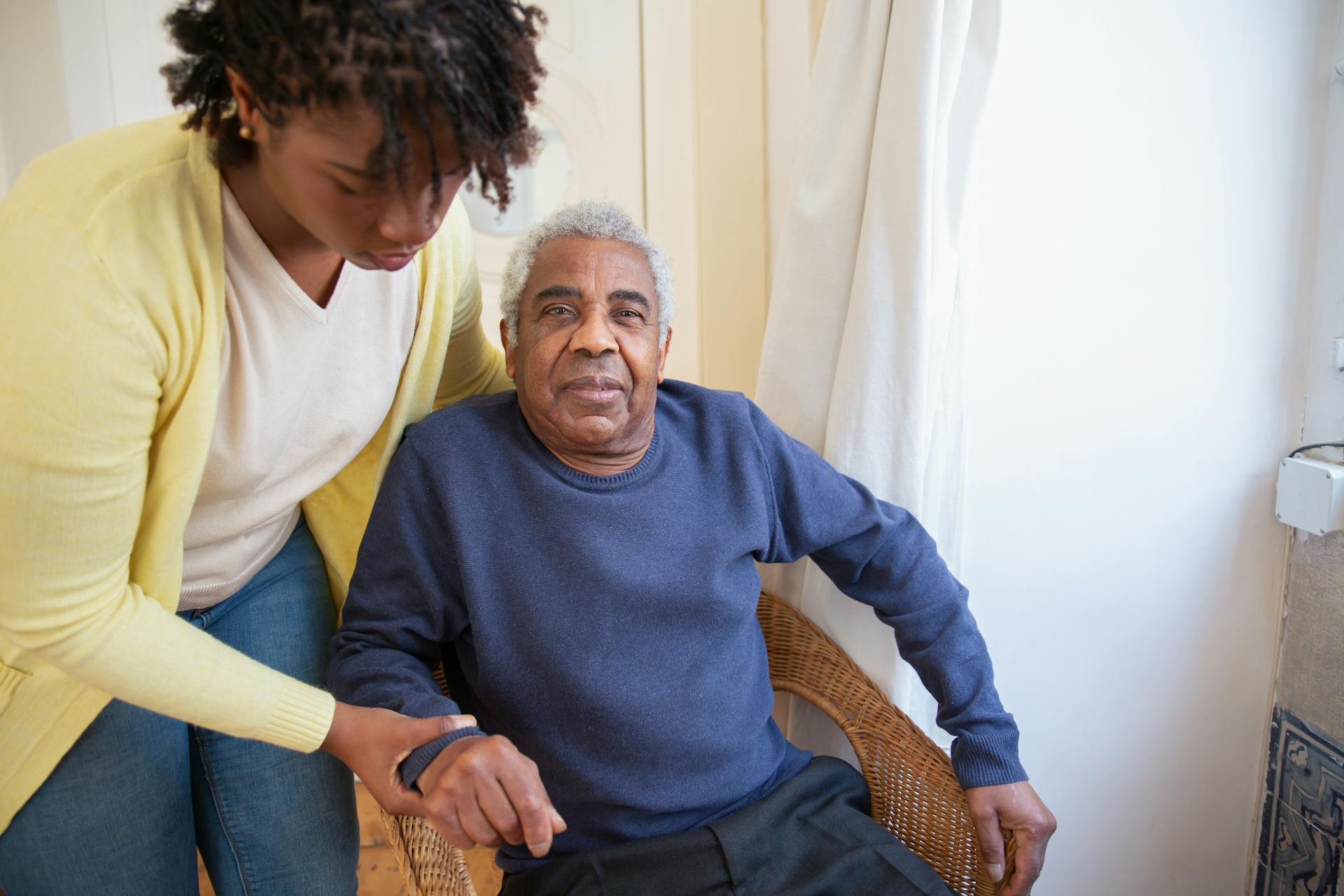
Copay assistance programs are designed to help patients afford their prescription medications by reducing or eliminating copays. These programs are often sponsored by pharmaceutical companies and can be a huge relief for those struggling to pay for their medication.
Many copay assistance programs have income limits, so patients must meet certain financial criteria to qualify. For example, a program may be limited to patients with incomes below $50,000 per year.
Some programs offer assistance for specific medications, while others are more general, covering a range of medications. This means that patients may need to check the eligibility criteria for each program to see if they qualify.
These programs can be a game-changer for patients who are struggling to afford their medication, allowing them to get the treatment they need without breaking the bank.
For another approach, see: Copay Assistance for Medicare Patients
What Are Copay Assistance Programs?
Co-pay assistance programs are a vital lifeline for many people dealing with medical expenses. These programs provide financial assistance to help cover co-pays and some out-of-pocket medical expenses.
Co-pay assistance foundations are funded by the pharmaceutical industry and private donors, making them a valuable resource for those in need. Each foundation has its own set of diagnostic and financial criteria that patients must meet to be eligible for assistance.
Some co-pay assistance programs cover the payment of health insurance premiums or COBRA premiums, which can be a huge help for those struggling to stay insured. Patients can receive assistance from multiple foundations, which can be a game-changer for those with high medical expenses.
Here are some key facts about co-pay assistance programs:
- Co-pay assistance does not cover off-label or experimental treatments.
- Each foundation has specific diagnostic and financial criteria a patient must meet to be eligible for assistance.
- Patients can receive assistance from multiple foundations.
- Some funds are available to assist with the payment of health insurance premiums or COBRA premiums.
Types of Copay Assistance
Copay assistance programs come in various forms, but they all share the same goal: to help patients with out-of-pocket medical expenses.
There are two primary types of copay assistance: co-pay assistance foundations and co-pay cards. Co-pay assistance foundations provide assistance with co-pays and some out-of-pocket medical expenses. They are funded by the pharmaceutical industry, as well as private donors.
Co-pay cards, on the other hand, offer instant rebates to patients through pharmaceutical manufacturers. These cards can only be used by patients with private/commercial insurance, and patients with Medicare, Medicaid, or Tricare are not eligible.
Here's a brief rundown of the key differences between co-pay assistance foundations and co-pay cards:
It's worth noting that patients can receive assistance from multiple foundations, but each foundation has its own specific diagnostic and financial criteria that patients must meet to be eligible.
What Is the Difference Between Programs?
Copay accumulator programs and copay maximizer programs may seem similar, but they have distinct approaches to handling copay assistance.
Copay accumulator programs identify third-party assistance payments and exclude them from deductibles and out-of-pocket maximums. This means beneficiaries are still responsible for cost-sharing when copay assistance runs out.
Copay maximizer programs declare certain medications as "nonessential health benefits" to bypass ACA regulations. They then set beneficiary cost-sharing based on the maximum copay assistance available from the manufacturer.
Once copay assistance is exhausted, copay maximizer programs drop the beneficiary's out-of-pocket cost to zero for that particular drug. However, the copay assistance doesn't count towards the deductible or out-of-pocket maximum, leaving beneficiaries with surprise costs for other medications or services.
For your interest: Copay Accumulator and Maximizer
Types of Copay Assistance
Co-pay assistance foundations provide a vital lifeline for many patients struggling with out-of-pocket medical expenses. These foundations are funded by the pharmaceutical industry and private donors, and each one has its own set of diagnostic and financial criteria that patients must meet to be eligible for assistance.
Co-pay assistance foundations cover co-pays and some out-of-pocket medical expenses, but they don't cover off-label or experimental treatments. Some funds are also available to assist with health insurance premiums or COBRA premiums.
Here are some key facts to keep in mind about co-pay assistance foundations:
- Co-pay assistance foundations provide assistance with co-pays and SOME out-of-pocket medical expenses.
- EACH foundation has specific diagnostic and financial criteria a patient must meet to be eligible for assistance.
- Co-pay assistance does not cover off-label or experimental treatments.
- Some funds are available to assist with the payment of health insurance premiums or COBRA premiums.
- Patients CAN receive assistance from multiple foundations.
Co-pay cards are another option available to patients, but they have some specific requirements. Co-pay cards are only for patients who have private/commercial insurance, and patients with Medicare, Medicaid, or Tricare are not eligible.
How to Get Copay Assistance
To get copay assistance, you can contact any of the foundations listed above directly to initiate an application. These foundations are funded by the pharmaceutical industry, as well as private donors, and provide assistance with co-pays and some out-of-pocket medical expenses.
You can also reach out to your oncology social worker, navigator, or a financial counselor in your cancer treatment center for help with the application process. They can assist you with determining what programs you may be eligible for and facilitate medical information getting to the foundation in a timely fashion.
To apply for copay assistance, you'll need to have the following information ready: your diagnosis and medications, your health insurance carrier and insurance member ID, your personal and contact information, including date of birth, mailing address, email address, and social security number, your adjusted gross annual household income, and your provider's contact information.
Here are some organizations that can help you with copay assistance:
- Cancer Care Co-Pay Foundation
- The Leukemia and Lymphoma Society Co-Pay Assistance Program (LLS)
- Patient Advocate Foundation Co-Pay Relief Program
- My Good Days (formerly the Chronic Disease Fund)
- The Healthwell Foundation
- Accessia Health (formerly Patient Services Incorporated)
- National Association for Rare Disorders (NORD)
- Patient Access Network Foundation
- The Assistance Fund
Am I Eligible?
To determine if you're eligible for copay assistance, first, you'll need to contact a disease fund directly or work with your cancer care team. They can help you navigate the process and find out which programs you may be eligible for.
You can reach out to any of the foundations listed above, or your oncology social worker, navigator, or financial counselor can assist you with the application process. They can also help facilitate the medical information needed for the application.
It's essential to communicate with your cancer care team about the costs of your care and how they're impacting your ability to participate in your treatment plan.
To be eligible for a copay grant, you'll need to meet specific criteria. These vary by disease fund, but typically include:
- Receiving treatment for the disease named in the disease fund or program
- Having the specified health insurance that covers your qualifying medication or product
- Having a prescribed medication that's listed as a covered medication within the disease fund
- Meeting the income requirements, which are based on the federal poverty level specified by the disease fund
- Residing and receiving treatment in the United States or U.S. territories
Here are the eligibility requirements in a concise format:
How to Apply
To apply for co-pay assistance, you can start by contacting any of the foundations listed above directly to initiate an application. Some foundations also have a pre-screening tool to help you determine your eligibility.
You can apply online through the PAN portal or by phone. To apply by phone, call 1-866-316-7263 Monday through Friday, 9 a.m. to 5:30 p.m. ET.
Check this out: Capecitabine Copay Assistance Phone Number
Healthcare professionals can apply online through the PAN portal or by phone on behalf of their patients.
Before you apply, make sure you have the necessary information, including your diagnosis and medications, health insurance carrier and insurance member ID, personal and contact information, adjusted gross annual household income, and your provider's contact information.
Here's a list of the information you'll need to have ready:
- Your diagnosis and medications
- Your health insurance carrier and insurance member ID
- Your personal and contact information, including date of birth, mailing address, email address, and social security number
- Your adjusted gross annual household income
- Your provider's contact information, including name and phone number
Understanding Copay Assistance
Co-pay assistance programs are funded by the pharmaceutical industry, as well as private donors, and provide assistance with co-pays and some out-of-pocket medical expenses.
Each foundation has specific diagnostic and financial criteria a patient must meet to be eligible for assistance, and patients can receive assistance from multiple foundations.
Some funds are available to assist with the payment of health insurance premiums or COBRA premiums, and co-pay assistance does not cover off-label or experimental treatments.
Here are some organizations that offer co-pay assistance:
- Cancer Care Co-Pay Foundation
- The Leukemia and Lymphoma Society Co-Pay Assistance Program (LLS)
- Patient Advocate Foundation Co-Pay Relief Program
- My Good Days (formerly the Chronic Disease Fund)
- The Healthwell Foundation
- Accessia Health (formerly Patient Services Incorporated)
- National Association for Rare Disorders (NORD)
- Patient Access Network Foundation
- The Assistance Fund
What You Need to Know
You must meet both diagnostic and financial criteria to qualify for assistance. These criteria vary from one co-pay assistance foundation to another, so it's essential to review the specific requirements for each foundation.
Co-pay assistance covers the costs of the medication, including oral and IV medications, but typically does not cover co-pays for diagnostic imaging, labs, or radiation. Some programs, like the Leukemia and Lymphoma Society Co-Pay Assistance Program, may cover office visit co-pays if the patient is receiving treatment on the same day.
Uninsured individuals are not eligible for co-pay assistance. This means that if you don't have health insurance, you won't be able to receive co-pay assistance, even if you meet the diagnostic and financial criteria.
Co-pay assistance differs from co-pay cards, which are sponsored by drug manufacturers. Co-pay cards are only available to patients with private/commercial insurance and do not cover patients with Medicare, Medicaid, or Tricare.
Here's a breakdown of the key differences between co-pay assistance and co-pay cards:
Patient Perceptions
Most patients view copay assistance positively, with over 70% having a very or somewhat positive perception. This is a relief for those who rely on these programs to make their medications more affordable.
Specialty pharmacy users don't have a significantly different perception of copay assistance compared to non-specialty pharmacy users. In fact, they're just as likely to have a positive opinion.
The COVID-19 pandemic has actually increased the proportion of patients viewing copay assistance more positively, particularly among specialty pharmacy users. This growth is significant, with 53% of specialty pharmacy users viewing copay assistance "somewhat or much more positive" compared to 24% of non-specialty pharmacy users.
If copay assistance were unavailable, patients would likely take on more debt or cut back in other areas. In fact, 81% of those who indicated they'd use a credit card to pay for their medications would also be likely to borrow money from family or friends, or use their savings.
Specialty pharmacy users are more likely to use their savings or retirement funds to cover the cost of their medications, with 44% doing so compared to 22% of non-specialty pharmacy users. They're also more likely to switch insurance plans, with 36% doing so compared to 22% of non-specialty pharmacy users.
Frequently Asked Questions
Who pays for patient assistance programs?
Patient assistance programs (PAPs) are typically funded by pharmaceutical companies, state programs, and non-profit organizations. These sponsors help make medications more affordable for eligible patients.
Why do pharmaceutical companies offer copay assistance?
Pharmaceutical companies offer copay assistance to encourage the use of their medications and help reduce out-of-pocket costs for consumers. This strategy aims to increase medication adherence and drive sales, while also providing financial relief to patients.
Sources
- https://primaryimmune.org/get-involved/advocate/addressing-copay-accumulators-and-maximizers
- https://www.kff.org/health-costs/issue-brief/copay-adjustment-programs-what-are-they-and-what-do-they-mean-for-consumers/
- https://www.oncolink.org/support/insurance-legal-employment-financial-concerns/access-to-medications/insurance-and-co-pay-assistance
- https://pmc.ncbi.nlm.nih.gov/articles/PMC10394206/
- https://www.panfoundation.org/apply-and-manage-grants/our-grants/co-pay-grants/
Featured Images: pexels.com


